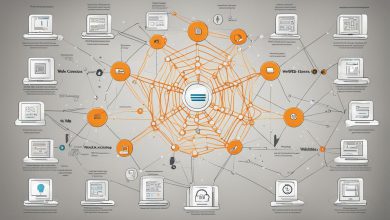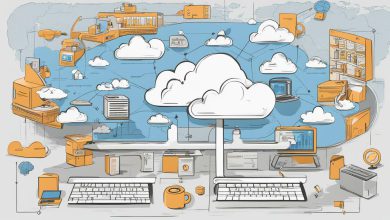Welcome to the ultimate guide for beginners to learn Docker. In this article, we will explore the world of Docker, which has revolutionized the containerization system, allowing developers to improve coding efficiency and streamline the application deployment process.
Docker is a powerful tool used in software development that allows you to create and manage containers. It can help you create a consistent environment to run your application, and make it easy to deploy across different platforms. With Docker, you will be able to develop, test, and deploy applications faster than ever before.
Key Takeaways:
- Docker is an essential tool for containerization, making it easier to manage and deploy applications.
- Docker provides a consistent environment, making it easier to test and deploy applications on different platforms.
- Docker improves coding efficiency, streamlining the application deployment process.
What is Docker?
If you’re new to Docker, you may be wondering what it is and how it fits into the containerization technology landscape. Docker is a containerization technology that allows developers to package and deploy their applications in a standardized environment, creating consistency across different systems. The Docker ecosystem includes a variety of tools and products that make it easy to work with containers and manage them at scale.
Containerization technology has changed the way developers think about deploying applications. In the past, each application would have its own operating system and libraries installed on the host machine, leading to inconsistencies and compatibility issues. With Docker, every application is packaged in its own container, which includes everything it needs to run, from the operating system to the application code and dependencies. This approach ensures that the application runs consistently across different environments, whether it’s a developer’s local machine or a production server.
Understanding Docker Architecture
Docker’s architecture is based on the client-server model, with the Docker client communicating with the Docker daemon through a RESTful API. The Docker daemon, also known as the Docker engine, is responsible for managing the Docker containers and images.
Docker containers are lightweight virtual machines that encapsulate an application and its dependencies. Docker containers are built from Docker images, which are read-only templates that contain instructions for creating a Docker container.
| Docker Image | Docker Container |
|---|---|
| Read-only template | Runnable instance |
| Created from a Dockerfile | Created from a Docker image |
| Enables consistent deployment across environments | Can be easily moved between hosts |
Docker images can be stored in registries, such as the Docker Hub, which provides a central location to share and distribute Docker images. Docker containers can be created, run, and managed using the Docker CLI or through the Docker API.
Understanding Docker architecture and the concepts of Docker containers and images is essential for effectively working with Docker and utilizing its benefits for containerization.
Getting Started with Docker
Before diving into Docker, it is important to have a container platform set up and ready to go. Docker Desktop is a great option for beginners and can be downloaded for free from the Docker website.
Once you have Docker Desktop installed, you can start working with Docker images. Docker images are templates that can be used to create Docker containers. You can find pre-built images on the Docker Hub, or create and use your own.
Creating a Docker image is simple. You start with a base image and then add the necessary components to create your desired environment. This can include installing software packages, configuring settings, and adding files and folders.
| Command | Description |
|---|---|
| docker build [OPTIONS] PATH | Builds an image from the Dockerfile located at the specified PATH. |
| docker images | Lists all Docker images currently on your system. |
| docker rmi [OPTIONS] IMAGE [IMAGE…] | Removes one or more Docker images from your system. |
Once you have created your image, you can use it to create a Docker container. A Docker container is an instance of an image that can be run as an isolated process on your system.
The following command can be used to create a Docker container:
docker run [OPTIONS] IMAGE [COMMAND] [ARG…]
With Docker, you can also manage multiple containers simultaneously. Docker provides several commands for managing containers, including:
| Command | Description |
|---|---|
| docker ps [OPTIONS] | Lists all Docker containers currently running on your system. |
| docker start [OPTIONS] CONTAINER [CONTAINER…] | Starts one or more stopped Docker containers. |
| docker stop [OPTIONS] CONTAINER [CONTAINER…] | Stops one or more running Docker containers. |
By following these steps, you can get started with Docker and begin to experience the benefits of containerization technology on your development projects.
Docker Container Management
Docker container management is an essential aspect of using Docker effectively. Docker containers are lightweight, portable and can be created and destroyed easily. With Docker, you can create, start, stop, and manage containers without any hassle.
Creating Docker Containers
The first step in Docker container management is creating a container. You can create a Docker container by using the Docker run command with the appropriate parameters. The run command creates a new container from an image and starts it.
For example, to create a new container from the Ubuntu image, you can use the following command:
docker run -it ubuntu:latest
This command creates a new Ubuntu container and attaches your terminal to it. The -it flag is used to attach an interactive terminal to the container.
Viewing Docker Containers
You can view the Docker containers that are currently running on your system by using the following command:
docker ps
This command displays a list of all the running Docker containers on your system. If you want to view all the Docker containers on your system, including the ones that are not running, you can use the following command:
docker ps -a
Stopping Docker Containers
You can stop a running Docker container by using the Docker stop command, followed by the container ID or name. For example, if you want to stop the container with the ID abcd1234, you can use the following command:
docker stop abcd1234
Starting Docker Containers
If you want to start a Docker container that you previously stopped, you can use the Docker start command, followed by the container ID or name. For example, if you want to start the container with the ID abcd1234, you can use the following command:
docker start abcd1234
Removing Docker Containers
You can remove a Docker container by using the Docker rm command, followed by the container ID or name. For example, if you want to remove the container with the ID abcd1234, you can use the following command:
docker rm abcd1234
Make sure to stop the container before attempting to remove it using the docker stop command.
Effective Docker container management is essential for working with Docker efficiently. By using the Docker commands mentioned above, you can create, view, start, stop and remove containers with ease.
Advanced Docker Features
Once beginners have mastered the basics of Docker, there are a number of advanced features they can explore to enhance their container platform. One of the most crucial of these is container orchestration.
Container orchestration involves the management of multiple Docker containers at scale. It aims to automate the deployment, scaling, and management of containerized applications. There are several container orchestration tools available, including Kubernetes, Docker Swarm, and Apache Mesos.
Kubernetes has emerged as the most popular container orchestration tool, owing to its flexibility and robustness. With Kubernetes, you can easily manage and scale containers across multiple nodes, allowing you to deploy applications with ease.
In addition to container orchestration, Docker also offers a number of features to enhance the platform’s functionality. These include Docker Compose, which allows you to define and run multi-container applications, and Docker Machine, which helps you to create Docker hosts on your local machine, cloud provider, or on-premises server.
By leveraging these advanced Docker features, developers can enhance their container platform and streamline the container orchestration process. Ultimately, this can lead to more efficient development workflows and better productivity.
Docker Security Best Practices
When using Docker for containerization, it is essential to ensure the security of Docker containers. Here are some best practices to follow:
- Keep Docker up-to-date: Ensure you have the latest version of Docker installed to have access to the latest security features and patches.
- Use only trusted images: Only use official Docker images or images from trusted sources. Verify the source before downloading the image.
- Minimize the attack surface: Identify and remove all unnecessary packages, services, and users from the Docker containers to minimize the attack surface.
- Limit container privileges: Use non-root Docker containers and restrict their privileges to only the necessary resources.
- Monitor and log: Monitor and log all Docker container activity to identify any suspicious behavior and take immediate action.
- Network security: Ensure Docker containers are only accessible by authorized personnel and use secure network settings to protect against unauthorized access.
By following these Docker security best practices, you can ensure the safety and security of your Docker containers and protect your data from potential security threats.
Integrating Docker into Development Workflow
If you’re a developer, you know how critical it is to have an efficient workflow. Docker can streamline the process of building, testing, and deploying your software, saving you time and effort. With Docker, you can create a development environment that mirrors your production environment, ensuring that your code works seamlessly across different systems. Here’s how you can integrate Docker into your development workflow to enhance coding efficiency and streamline the containerization process.
Docker Compose
Docker Compose is a powerful tool that allows you to define and run multi-container Docker applications. With Docker Compose, you can orchestrate your application’s containers, define their dependencies, and specify their configuration in a single file. This makes it easy to set up your development environment and deploy your application to production. You can use Docker Compose to define your application’s network, volumes, and environment variables, as well as configure its logging and monitoring.
Dockerfile
A Dockerfile is a script that defines the steps needed to create a Docker image. With a Dockerfile, you can automate the process of building your container, ensuring that your application is built consistently every time. You can use a Dockerfile to specify which base image to use, what commands to run, and which files to copy into the container. This allows you to create a reproducible and consistent container image that can be deployed across different environments.
Docker Registries
Docker registries are servers that store Docker images and provide an easy way to distribute them across different environments. You can use Docker registries to share your container images with other developers, or to deploy them to production. Docker Hub is the most popular Docker registry, but you can also use private registries to store your images. Docker registries allow you to version your images, tag them, and manage their access control.
By integrating Docker into your development workflow, you can improve your coding efficiency, streamline the containerization process, and ensure that your code works seamlessly across different systems. Docker Compose, Dockerfile, and Docker registries are powerful tools that can help you achieve these goals, so be sure to include them in your Docker toolkit.
Docker in Production
Using Docker in production environments provides numerous benefits, including increased flexibility and scalability. However, managing Docker containers in a production environment can be complex and require careful consideration.
One of the key advantages of Docker in production is the ability to scale services quickly and easily. Docker’s container platform makes it simple to replicate services across multiple nodes, allowing for load balancing and improved performance.
However, managing Docker containers in a production environment requires careful attention to security and resource management. It is essential to implement best practices for securing Docker containers, such as limiting container privileges and monitoring for vulnerabilities.
In addition, proper resource management is crucial for optimal container performance. This includes setting appropriate resource limits for containers and using automation tools to manage container lifecycles.
Using Docker in production also requires a robust monitoring and logging strategy. Monitoring tools can help identify performance issues, while logging can provide valuable insights into how containers are interacting with other components in the system.
Overall, Docker provides a powerful container platform for use in production environments. With careful attention to security, resource management, and monitoring, Docker can help organizations achieve greater flexibility, scalability, and efficiency.
Docker vs. Other Containerization Technologies
Docker is not the only containerization technology available in the market. However, it is by far the most popular and widely used. Here, we will compare Docker with other containerization technologies, discussing the advantages and disadvantages of each.
Kubernetes
Kubernetes is another containerization technology that has gained popularity in recent years. It allows users to automate deployment, scaling, and management of containerized applications. Compared to Docker, Kubernetes is more complex and difficult to use, requiring a higher level of technical knowledge. However, it offers a more robust container management system, making it a better choice for larger and more complex applications.
OpenVZ
OpenVZ is a containerization technology that operates at the operating system (OS) level. Unlike Docker, which uses a virtualization system, OpenVZ provides isolated environments within a single OS instance. This makes it more lightweight and efficient than Docker, but it also means that it lacks some of the features and flexibility of a complete virtualization system.
LXC
LXC, or Linux Containers, is another containerization technology that operates at the OS level. It is similar to OpenVZ but offers more flexibility and features, allowing users to run multiple isolated Linux systems on a single host. However, it can be more challenging to set up and use than Docker, requiring a higher level of technical expertise.
Conclusion
When it comes to containerization technology, Docker is the most popular and widely used option. However, other containerization technologies such as Kubernetes, OpenVZ, and LXC have their own unique advantages and disadvantages. The choice of containerization technology ultimately depends on the specific needs and requirements of the application being developed or deployed.
Conclusion
Overall, Docker is a game-changer for those seeking to streamline their containerization and coding efficiency. By leveraging the power of Docker to create and manage containers, developers can save time and improve the consistency of their work.
In this ultimate guide, we’ve covered the basics of Docker, introduced its architecture, and highlighted various ways to utilize its features. We’ve explored best practices for securing Docker containers, and we’ve even touched on integrating Docker into the development workflow and using it in production environments.
By mastering Docker, developers can achieve a level of containerization that is unrivaled by other technologies. While other containerization technologies certainly exist, Docker stands as the clear leader in container management, offering unparalleled functionality and flexibility.
The Future of Docker
As Docker continues to evolve and improve, we can expect to see even more benefits emerging. Whatever the future holds, however, it’s clear that Docker is set to be a key technology for improving containerization and coding efficiency for years to come. So why wait? Start exploring Docker today and unlock its full potential for your development work.
FAQ
Q: What is Docker?
A: Docker is a containerization technology that allows you to package applications and their dependencies into a standardized unit called a container.
Q: What is the role of Docker in the Docker ecosystem?
A: Docker is the primary component of the Docker ecosystem, providing the fundamental tools and platform for containerization.
Q: What is Docker architecture?
A: Docker architecture is the structure and design of Docker. It consists of Docker containers, which are lightweight, isolated environments that run applications, and Docker images, which are the building blocks for containers.
Q: How do I get started with Docker?
A: To get started with Docker, you need to set up a container platform, such as Docker Desktop, and learn how to work with Docker images to run applications in containers.
Q: How do I manage Docker containers?
A: Docker container management involves creating, starting, stopping, and removing containers. You can use Docker commands or tools like Docker Compose to manage containers effectively.
Q: What are some advanced features of Docker?
A: Docker offers advanced features like container orchestration, which allows you to manage multiple containers and their interactions efficiently.
Q: How can I ensure Docker security?
A: To ensure Docker security, it is essential to follow best practices such as using secure images, minimizing container privileges, and regularly updating Docker components.
Q: How can I integrate Docker into my development workflow?
A: You can integrate Docker into your development workflow by using Docker containers to create reproducible environments, streamline the deployment process, and improve coding efficiency.
Q: How can Docker be used in production environments?
A: Docker can be used in production environments to create scalable and reliable container platforms, ensuring efficient management of Docker containers.
Q: How does Docker compare with other containerization technologies?
A: Docker is one of the most popular containerization technologies, offering a wide range of features and a large community support. Comparing Docker with other containerization technologies can help you determine the best fit for your specific needs.







